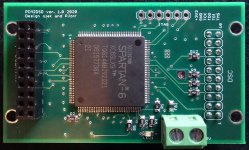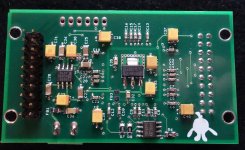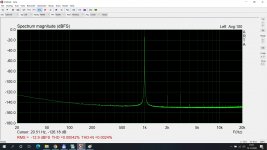MarcelvdG,
I'm so sorry - I think I just stereotyped you there 😀 working in AV and based in the Netherlands - was theer anything but Philips 😀
Such a shame how the once great Philips has been decimated over the years... What happens when a company is run by short term looking accountants rather then longer term engineer's..
I'm guessing you worked in the video industry with the choice of 27MHz as your Audio systems Masterclock?
I'm so sorry - I think I just stereotyped you there 😀 working in AV and based in the Netherlands - was theer anything but Philips 😀
Such a shame how the once great Philips has been decimated over the years... What happens when a company is run by short term looking accountants rather then longer term engineer's..
I'm guessing you worked in the video industry with the choice of 27MHz as your Audio systems Masterclock?
John,
27MHz is also the clock frequency Benchmark Media chose for their ASRC reference clock. The reason was that it was high enough to be well removed from standard audio clock frequencies, it allowed use of a better custom interpolation filter design, and it wasn't too high a frequency for SRC4392. Only reason I didn't want to use that 27MHz frequency myself was because much better audio clocks are available at standard frequencies.
27MHz is also the clock frequency Benchmark Media chose for their ASRC reference clock. The reason was that it was high enough to be well removed from standard audio clock frequencies, it allowed use of a better custom interpolation filter design, and it wasn't too high a frequency for SRC4392. Only reason I didn't want to use that 27MHz frequency myself was because much better audio clocks are available at standard frequencies.
Originally I started with 28.224 MHz, as that is an integer multiple of the most usual sample rates, and tried to phase lock a 28.224 MHz crystal oscillator with the incoming clock. As that didn't work out, I switched to asynchronous sample rate conversion and a free-running crystal oscillator. I then just picked a frequency close to 28.224 MHz that was not likely to cause audible mixing products with the incoming clocks. See section 5 and particularly table 3 of https://linearaudio.net/sites/linearaudio.net/files/03 Didden LA V13 mvdg.pdf for details.
@ JohnW,
Hi Everyman, please forgive my intrusion in your thread.
JohnW, I sent you a PM was wondering if you'd be kind enough to reactivate the links
you posted over in the Rohde & Schwarz UPD thread or if you would be kind enough to post new links in the Rohde & Schwarz UPD: Troubleshoot then Restore to Glory thread: LINK
The new thread should be beneficial to everyone interested in these instruments.
Cheers,
Postscript, Members of, "Simple DSD SRC for BeagleBone" Thank you for your patience and consideration, I'll keep any future posts related the to the topic at hand.
Hi Everyman, please forgive my intrusion in your thread.
JohnW, I sent you a PM was wondering if you'd be kind enough to reactivate the links
you posted over in the Rohde & Schwarz UPD thread or if you would be kind enough to post new links in the Rohde & Schwarz UPD: Troubleshoot then Restore to Glory thread: LINK
The new thread should be beneficial to everyone interested in these instruments.
Cheers,
Postscript, Members of, "Simple DSD SRC for BeagleBone" Thank you for your patience and consideration, I'll keep any future posts related the to the topic at hand.
outstanding DAC (DSC2 + DSDit) from Russia
I was very lucky and got an outstanding DAC (DSC2 + DSDit) from Russia to listen to for a few days. As far as I understand, Pavel Pogodin is its designer and Alexey Zhidkov made it.
I can hardly find words to describe how different this device is from all the other digital audio sources I have listened to so far in my listening room.
Once the device is properly setup (it is very important that it stands on a mechanically quiet surface due to the operation of the basic clock) and after it is sufficiently played / warmed up (minimum 24 hours of initial playback), the music that will appear from the stage in front of you will take you directly to the venue. The scene will be complete and convincing, from the very left to the very right edge (absolutely nothing comes from the speakers themselves).
You will easily notice 2 pianos from the album "Martha Argerich / Mikhail Pletnev Prokofiev: Cinderella / Ravel: Ma Mère l'Oye" or recognize the difference in the rattle on the right side of "Rebecca Pidgeon - Spanish Harlem".
I could list all the recordings I enthusiastically listened to using DSC2-DSDit, but instead I will just mention that the dispersion of sound, rich timbre and precision of tempo and rhythm in music can only be compared to listening to my friend, an experienced audiophile who listens to music only through the best turntables and tape recorders: (Kuzma 4 point, Eminent Technology II air, Micro seiki 505; Lyra Skala, Koetsu Rosewood, Urushi gold, Jade; Studer A80, A820, Revox PR99 MKIII, B77, Tascam BR20 ...)
Warm recommendation for DSC2-DSDit, my rating is definitely 10/10.
I was very lucky and got an outstanding DAC (DSC2 + DSDit) from Russia to listen to for a few days. As far as I understand, Pavel Pogodin is its designer and Alexey Zhidkov made it.
I can hardly find words to describe how different this device is from all the other digital audio sources I have listened to so far in my listening room.
Once the device is properly setup (it is very important that it stands on a mechanically quiet surface due to the operation of the basic clock) and after it is sufficiently played / warmed up (minimum 24 hours of initial playback), the music that will appear from the stage in front of you will take you directly to the venue. The scene will be complete and convincing, from the very left to the very right edge (absolutely nothing comes from the speakers themselves).
You will easily notice 2 pianos from the album "Martha Argerich / Mikhail Pletnev Prokofiev: Cinderella / Ravel: Ma Mère l'Oye" or recognize the difference in the rattle on the right side of "Rebecca Pidgeon - Spanish Harlem".
I could list all the recordings I enthusiastically listened to using DSC2-DSDit, but instead I will just mention that the dispersion of sound, rich timbre and precision of tempo and rhythm in music can only be compared to listening to my friend, an experienced audiophile who listens to music only through the best turntables and tape recorders: (Kuzma 4 point, Eminent Technology II air, Micro seiki 505; Lyra Skala, Koetsu Rosewood, Urushi gold, Jade; Studer A80, A820, Revox PR99 MKIII, B77, Tascam BR20 ...)
Warm recommendation for DSC2-DSDit, my rating is definitely 10/10.
Do you know if someone can do the same job as AK4137 with FPGA?
Yes.
I have done this with my friend PJotr.
This little board has an i2s/dsd input (Amanero style). Dsd is passed thru unchanged, PCM up to 24/192 is converted to a DSD256 stream via upsampler and sigma delta 7th order 1-bit modulator.
Output connector fits perfectly to the dsc board.
Currently I'm working on an RTZ version of the dsc.
Attachments
This is really nice, any chance you would sell these? Or share the code so we can make our own?
This little board has an i2s/dsd input (Amanero style). Dsd is passed thru unchanged, PCM up to 24/192 is converted to a DSD256 stream via upsampler and sigma delta 7th order 1-bit modulator.
Very interesting development, congratulations.
Are you open to sharing it?
Cool that you managed to squeeze it all into an XC6SLX9! I had difficulty enough fitting everything into an XC6SLX45.
Very interesting development, congratulations.
Are you open to sharing it?
Not this version, I think RTZ will be much more interesting.
How does it sound? How does it measure?
The sound is comparable to HQPlayer, so is not bad. I'm quite happy with the results. It measures like ordinary dsc.
Cool that you managed to squeeze it all into an XC6SLX9! I had difficulty enough fitting everything into an XC6SLX45.
This is much simpler project than Valve DAC 🙂
Main trick is that I'm using CSD arithmetics, so there is no multipliers in the modulator. Long carry chain path is the limit.
Attachments
Yes.
I have done this with my friend PJotr.
This is the one I was looking for ...

I would like to see an "integration" of this unit with Pure software, in order to have a fully working fron-end as the DSD SRC ... and avoid akm4137!
Not this version, I think RTZ will be much more interesting.
Forgive my deep ignorance, but... what RTZ stands for ?
Before too much excitement over a new modulator, it should probably be understood they don't all sound the same, at least if the dac is clean enough to make differences audible. Consider that in HQ Player there are a number of different DSD modulators which all sound different. The one in AK4137 is pretty darn good, but only shows itself best if the implementation around the AK4137 is good. As with dacs chips, implementation matters.
Also, some may recall CT7302. Looked good on paper. No one here is clamoring for a dac with one of those now.
Maybe good to remain patient and see how things go.
Also, some may recall CT7302. Looked good on paper. No one here is clamoring for a dac with one of those now.
Maybe good to remain patient and see how things go.
Last edited:
The differences between modulators are especially important when the DAC is imperfect.
For example, with a small DC offset at its input, a straightforward single-bit sigma-delta modulator will produce a big tone just above and a big tone just below fs/2 - and both tones get frequency-modulated when you play soft music. An ideal DAC will just convert those to tones/frequency modulates just above and below fs/2 that get filtered off by the reconstruction filter. An imperfect DAC will also produce intermodulation products that can end up in the audible band.
For example, with a small DC offset at its input, a straightforward single-bit sigma-delta modulator will produce a big tone just above and a big tone just below fs/2 - and both tones get frequency-modulated when you play soft music. An ideal DAC will just convert those to tones/frequency modulates just above and below fs/2 that get filtered off by the reconstruction filter. An imperfect DAC will also produce intermodulation products that can end up in the audible band.
- Home
- Source & Line
- Digital Line Level
- Simple DSD SRC for BeagleBone


